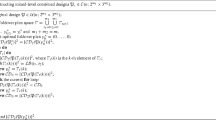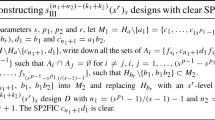Abstract
Clear effects criterion is one of the important rules for selecting optimal fractional factorial designs, and it has become an active research issue in recent years. Tang et al. derived upper and lower bounds on the maximum number of clear two-factor interactions (2fi’s) in 2n−(n−k) fractional factorial designs of resolutions III and IV by constructing a 2n−(n−k) design for given k, which are only restricted for the symmetrical case. This paper proposes and studies the clear effects problem for the asymmetrical case. It improves the construction method of Tang et al. for 2n−(n−k) designs with resolution III and derives the upper and lower bounds on the maximum number of clear two-factor interaction components (2fic’s) in 4m2n designs with resolutions III and IV. The lower bounds are achieved by constructing specific designs. Comparisons show that the number of clear 2fic’s in the resulting design attains its maximum number in many cases, which reveals that the construction methods are satisfactory when they are used to construct 4m2n designs under the clear effects criterion.
Similar content being viewed by others
References
Addelman S. Orthogonal main-effect plans for asymmetrical experiments. Technometrics, 4: 21–46 (1962)
Wu C F J. Construction of 2m4n designs via a grouping scheme. Ann Statist, 17: 1880–1885 (1989)
Wu C F J, Zhang R C, Wang R. Construction of asymmetrical orthogonal arrays of the type \( OA(s^k ,(s^{r_1 } )^{n_1 } )(s^{r_t } )^{n_t } ) \). Statist Sinica, 2: 203–219 (1992)
Box G E P, Hunter J S. The 2k−p fractional factorial designs. Technometrics, 3: 311–351, 449–458 (1961)
Fries A, Hunter W G. Minimum aberration 2k−p designs. Technometrics, 22: 601–608 (1980)
Wu C F J, Zhang R C. Minimum aberration designs with two-level and four-level factors. Biometrika, 80: 203–209 (1993)
Zhang R C, Shao Q. Minimum aberration (s 2)s n−k designs. Statist Sinica, 11: 213–223 (2001)
Mukerjee R, Wu C F J. Minimum aberration designs for mixed factorials in term of complementary sets. Statist Sinica, 11: 225–239 (2001)
Ai M Y, Zhang R C. Characterization of minimum aberration mixed factorials in terms of consulting designs. Statist Papers, 46(2): 157–171 (2005)
Wu C F J, Chen Y. A graph-aided method for planning two-level experiments when certain interactions are important. Technometrics, 34: 162–175 (1992)
Tang B, Ma F, Ingram D, Wang H. Bounds on the maximum number of clear two-factor interactions for 2m−p designs of resolution III and IV. Canad J Statist, 30: 127–136 (2002)
Chen H, Hedayat A S. 2n−m designs with resolution III or IV containing clear two-factor interactions. J Statist Plann Inference, 75: 147–158 (1998)
Wu H, Wu C F J. Clear two-factor interactions and minimum aberration. Ann Statist, 30: 1496–1511 (2002)
Ai M Y, Zhang R C. s n−m designs containing clear main effects or clear two-factor interactions. Statist Probab Lett, 69: 151–160 (2004)
Ke W, Tang B, Wu H. Compromise plans with clear two-factor interactions. Statist Sinica, 15: 709–715 (2005)
Yang G J, Liu M Q, Zhang R C. Weak minimum aberration and maximum number of clear two-factor interactions in 2 m−pIV designs. Sci China Ser A-Math, 48(11): 1479–1487 (2005)
Zhao S L, Zhang R C. 2m4n designs with resolution III or IV containing clear two-factor interaction components. Statist Papers, 49: 441–454 (2008)
Li P F, Chen B J, Liu M Q, Zhang R C. A note on minimum aberration and clear criteria. Statist Probab Lett, 76: 1007–1011 (2006)
Yang G J, Liu M Q. A note on the lower bounds on maximum number of clear two-factor interactions for 2 m−pIII and 2 m−pIV designs. Comm Statist Theory Methods, 35: 849–860 (2006)
Chen B J, Li P F, Liu M Q, Zhang R C. Some results on blocked regular 2-level fractional factorial designs with clear effects. J Statist Plann Inference, 136(12): 4436–4449 (2006)
Yang J F, Li P F, Liu M Q, Zhang R C. \( 2^{(n_1 + n_2 ) - (k_1 + k_2 )} \) fractional factorial split-plot designs containing clear effects. J Statist Plann Inference, 136(12): 4450–4458 (2006)
Zi X M, Liu M Q, Zhang R C. Asymmetrical designs containing clear effects. Metrika, 65(1): 123–131 (2007)
Zi X M, Zhang R C, Liu M Q. Bounds on the maximum numbers of clear two-factor interactions for \( 2^{(n_1 + n_2 ) - (k_1 + k_2 )} \) fractional factorial split-plot designs. Sci China Ser A-Math, 49(12): 1816–1829 (2006)
Cheng C S, Steinberg D M, Sun D X. Minimum aberration and model robustness for two-level factorial designs. J Roy Statist Soc Ser B, 61: 85–93 (1999)
Cheng C S, Mukerjee R. Regular fractional factorial designs with minimum aberration and maximum estimation capacity. Ann Statist, 26: 2289–2300 (1998)
Author information
Authors and Affiliations
Corresponding author
Additional information
This work was supported by the National Natural Science Foundation of China (Grant Nos. 10571093, 10671099 and 10771123), the Research Foundation for Doctor Programme (Grant No. 20050055038) and the Natural Science Foundation of Shandong Province of China (Grant No. Q2007A05). Zhang’s research was also supported by the Visiting Scholar Program at Chern Institute of Mathematics.
Rights and permissions
About this article
Cite this article
Zhao, S., Zhang, R. & Liu, M. Some results on 4m2n designs with clear two-factor interaction components. Sci. China Ser. A-Math. 51, 1297–1314 (2008). https://doi.org/10.1007/s11425-008-0084-1
Received:
Accepted:
Published:
Issue Date:
DOI: https://doi.org/10.1007/s11425-008-0084-1




